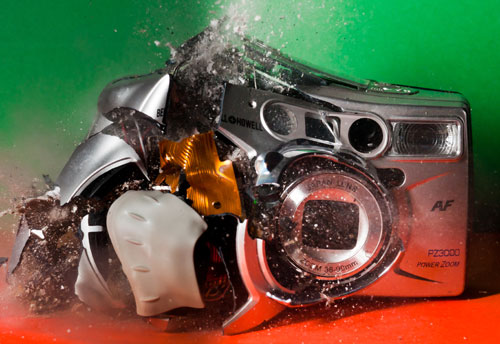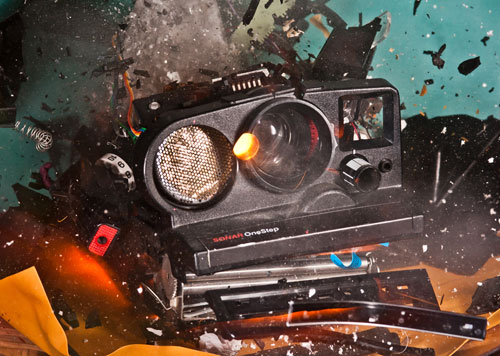Alan Sailer’s spectacular high-speed photos of exploding cameras
posted Tuesday, October 23, 2012 at 1:35 PM EDT
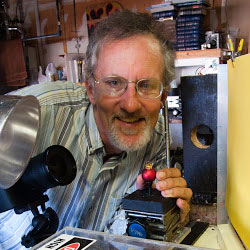
(Editor's note: Photographer Alan Sailer captured the spectacular images of exploding cameras on this page with a Nikon D90, using high-speed photography techniques. The following is text he sent us explaining the process behind these mind-blowing shots. To see more of Sailer's images, check out his Flickr page.)
I captured these explosive images using the basic technique of high-speed photography, i.e. a long shutter speed in a dark room with the flash going off at some point to capture the image. Basically the flash is acting as a virtual shutter.
So the two important bits to this type of photography are the ultra high speed flash and the detector that sets off the flash at the right instant.
The Flash
Harold Edgerton designed it in the 1950s. You take a high voltage capacitor and charge it to 20,000 volts and let the capacitor discharge on the surface of a quartz test tube. The thing is bright and fast, about 5 million+ in candlepower in about one millionth of a second.
A bullet traveling at the speed of sound moves about 10 thousandths of an inch in that time, nearly blur free.
The Detector
The detector is a lot safer and simpler. The basic technique is the same as wildlife photographer Stephen Dalton uses. In my case, I set up a LED emitting a beam of infrared light, invisible to the eye and the camera. I placed a detector of infrared light about two feet from the IR LED.
When something interrupts the beam, in this case a random camera part, it triggers the detector, which sends a signal to the flash to, well...flash.
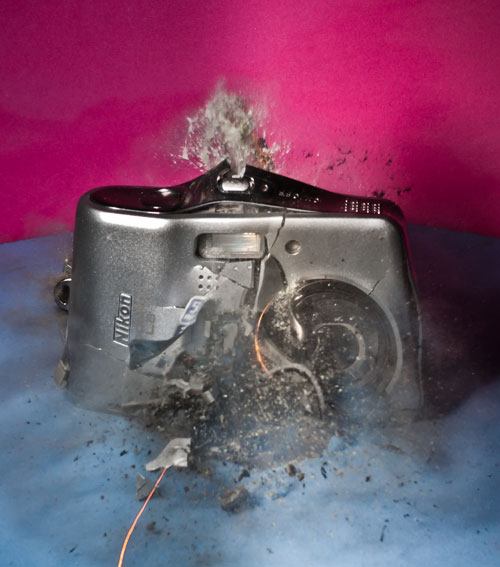
The camera is caught in the middle of flying apart. If you place this detector close to the camera, you get the early break-up, further and you get the later break-up.
There is a good deal of guess and hope since it is hard to determine what the right distance is. A great number of my shots are too late or too early. But with time, practice and luck I can get a good picture fairly often.
The Explosion
The firecracker for the explosion is a home-brew also. It is best to have an explosion that I can detonate electrically, so I built up a small firecracker that has an electrical contact that will detonate the thing fairly accurately.
So the procedure is to drill a hole in the camera (I get them from garage sales cheap), put the firecracker in place and connect the electrical contacts. I then set up the camera/flash/detector and decide on a distance from the detector IR beam to the camera. I focus the camera at a point where I expect the debris to hit the beam and set the camera on remote control.
I arrange the two flashes and then take a couple of test pictures to make sure the lighting is fine.
Then I turn out the lights, press the remote to open the camera shutter (~1 second) and then fire the cracker. (I hide behind a small screen so I don't get hit by debris).
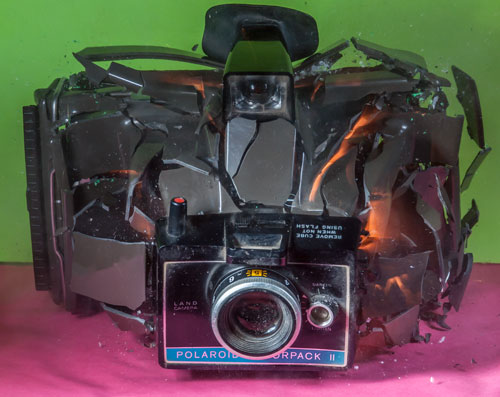
I then go check to see if I got the picture. Usually I only have one try so I then move on to another target.
I spend lots of time cleaning up and my garage is still a mess.
The Demolished Cameras
This might sound strange but for the most part I don't enjoy destroying old cameras.
Out of the four pictured, three were still working cameras, purchased at garage sales. I only blow them up because I am hoping to get an interesting picture.
The little pocket Nikon, though, I can feel good about. It was broken and was only heading to the electronics recycle bin.
